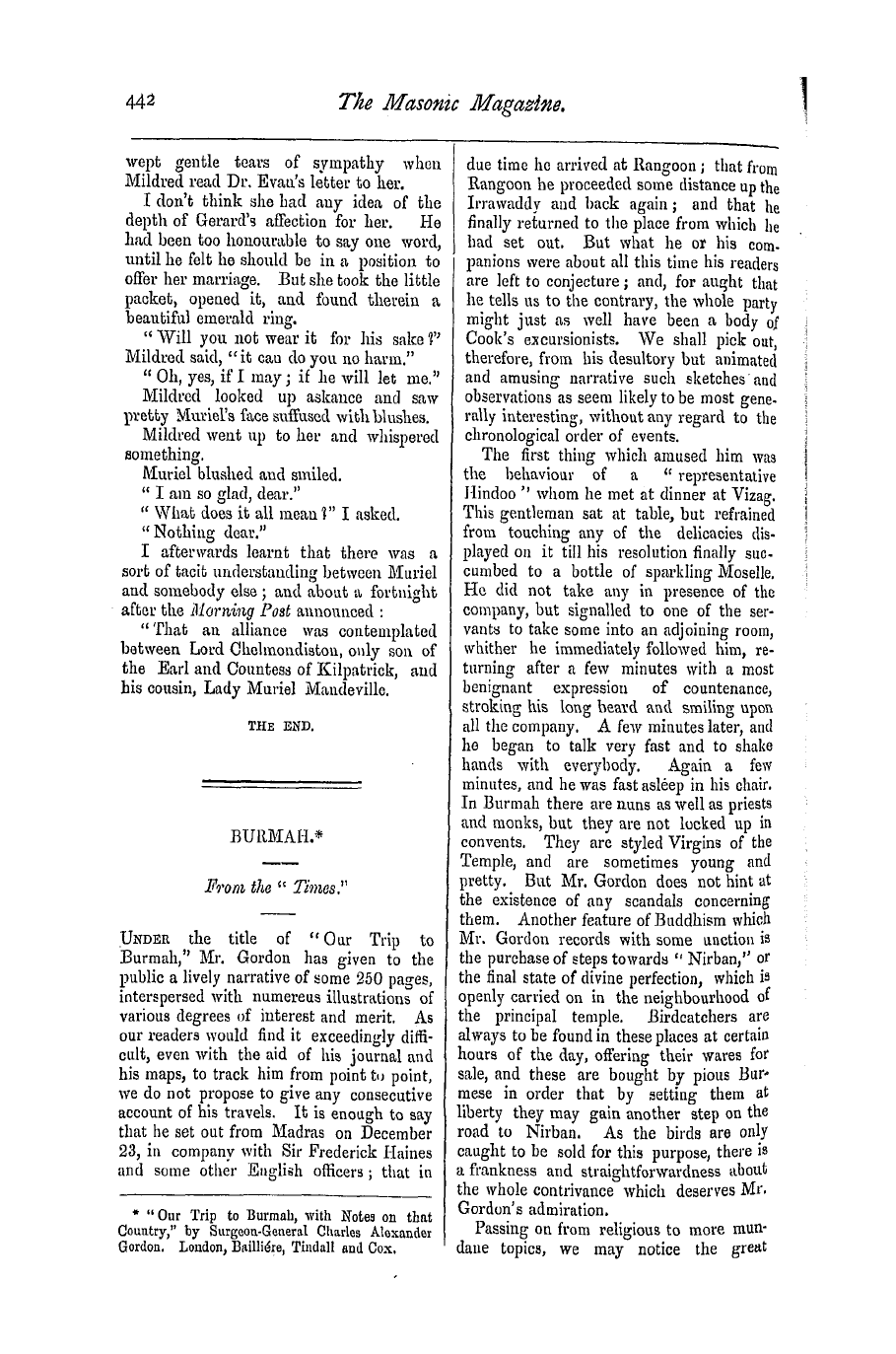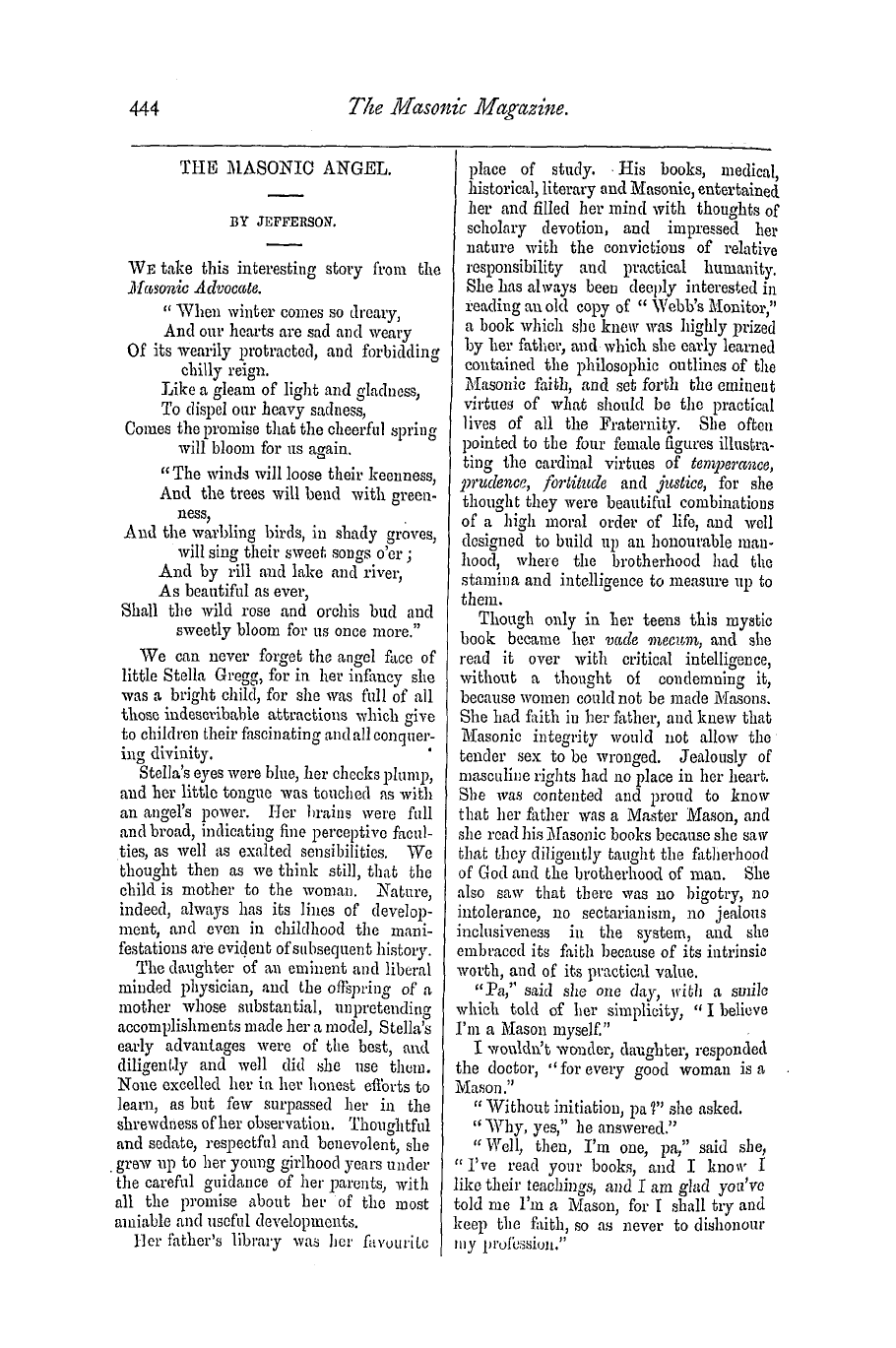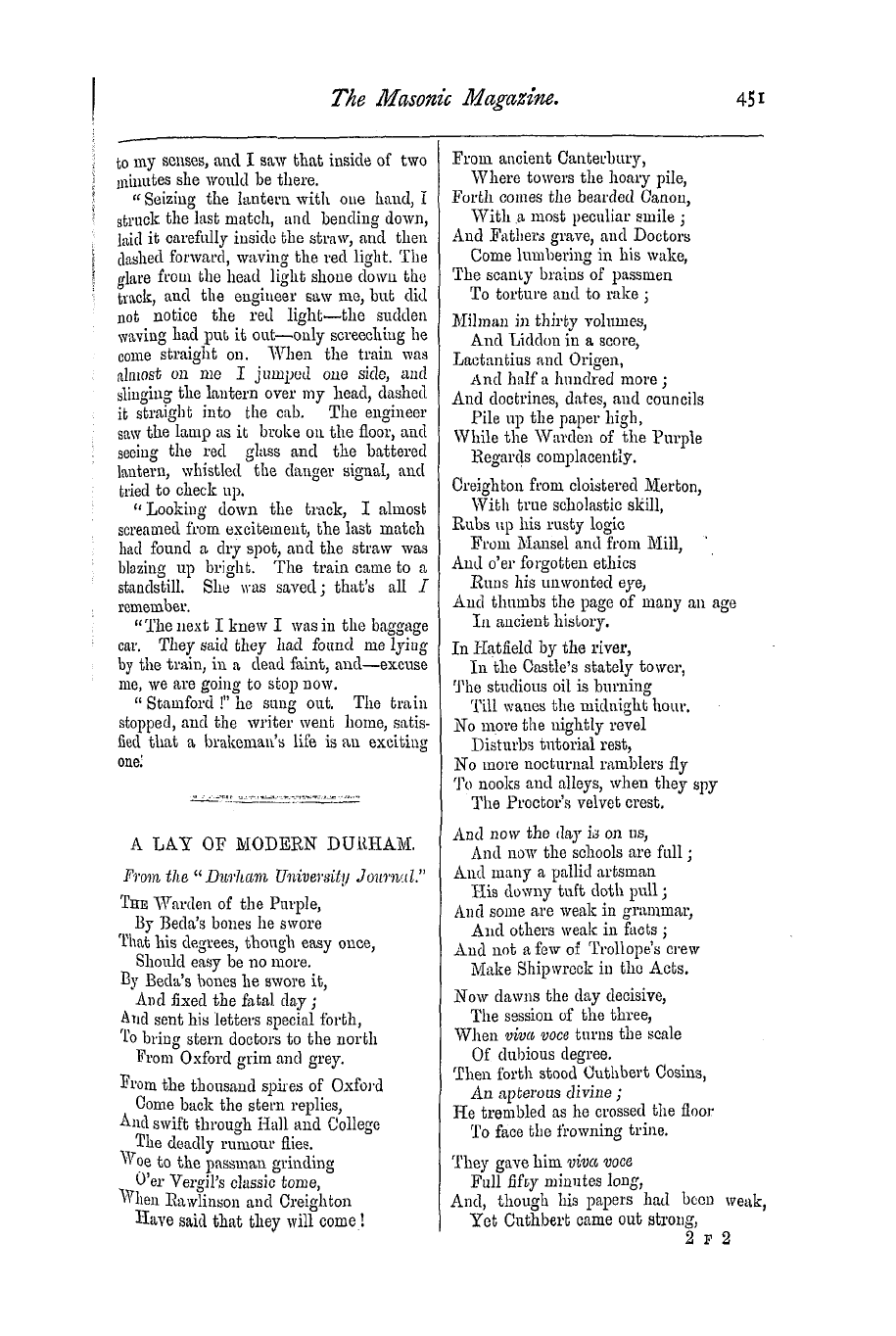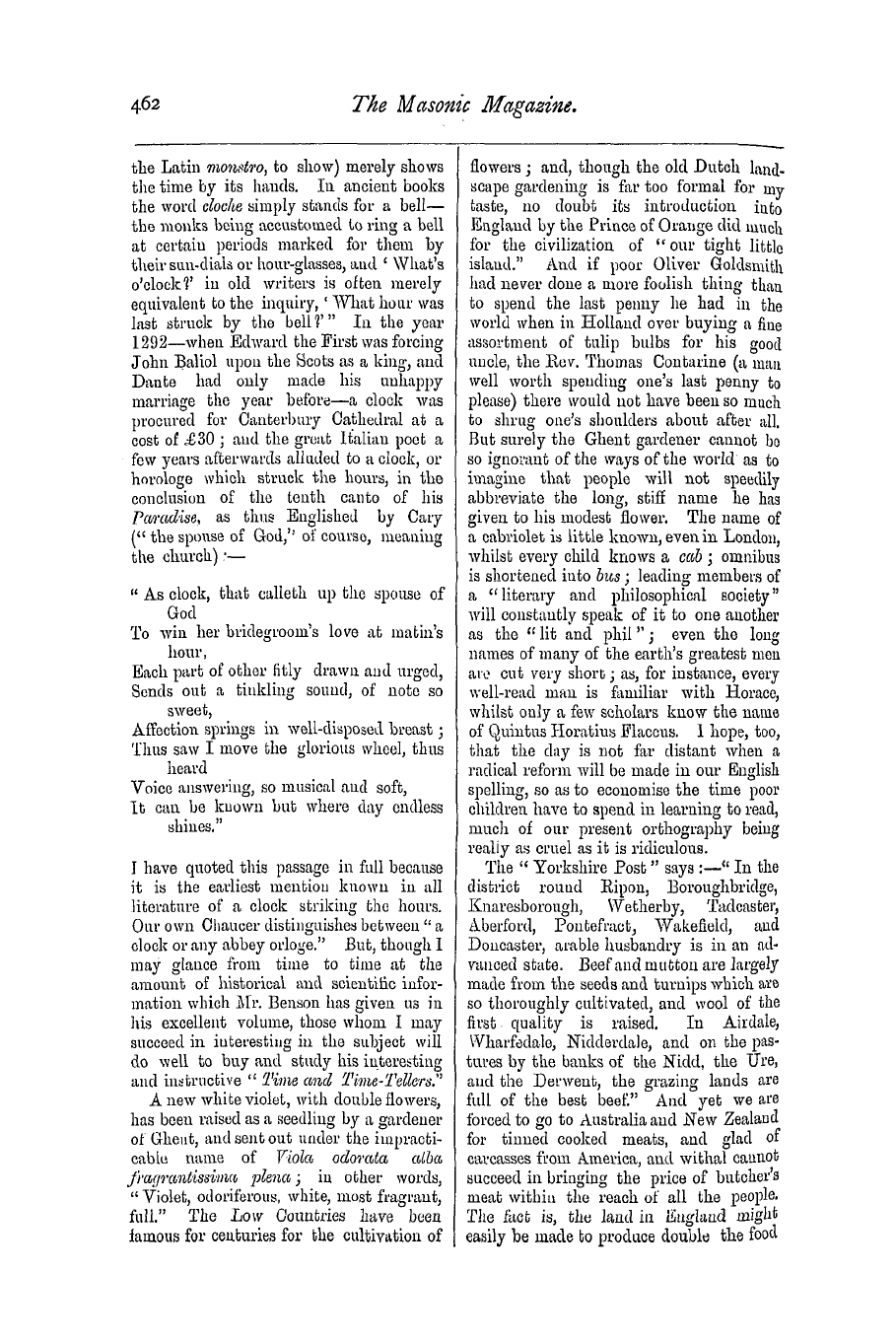Note: This text has been automatically extracted via Optical Character Recognition (OCR) software.
The Ancient Mysteries And Modern Freemasonry; Their Analogies Considered.
Almost every country of pagan antiquity has its OAvn mysteries peculiar to itself . Thus , in the island of Samothrace Ave find the Mysteries of the Cabiri ; at Athens they celebrated the Elusinian Mysteries ; in Egypt they had the Mysteries of Osiris ;
in Persia those of Mithras , Avhich Avere the last to perish after the adA'ent of Christianity . These Mysteries , differing as they do in name , Avere essentially the same in general form . They vieve all dramatic iu their " getting up ; " each one presented
, in a series of theatrical scenes , the adventures of some god or hero , Avith his sufferings from the attacks of his enemies , his death at their hands , his descent into the graA'c , or into Hades , ancl his final rising again . The only essential difference
between those various mysteries Avas that there Avas to each one a different and peculiar god or hero , Avhose life and acl-A'entures , whose death and resurrection , or apotheosis , constituted tho subject of the drama . Thusin Samothrace it Avas Atys
, Avho Avas slain ancl restored , in Egypt it Avas Osiris , at Athens it Avas Dionysus , and in Persia it was Mithras . But hi all of them the essential ingredients of the plot
Avere identical , and tho dramatic form , the theatrical representation of the allegory , Avas everyAvhore preserved . This dramatic form of the rites in the Mysteries—this acted allegory in which the doctrine of the resurrection Avas inculcated by the visible
representation of some fictitious history—Avas , as the learned Dr . Dollinger has justly observed , " eminently calculated to take a powerful hold on the imagination and the heart , and to excite iu the spectators alternate ! } ' conflicting sentiments of terror
and calmness , sorrow and fear and hope . " Now , the recognized fact that this mode of inculcating a philosophical or reli gious idea by a dramatic representation Avould naturally lead to its adoption by all other associations where the same lesson AA'as to
bo inculcated as that taught in the Ancient Mysteries . The tendency to dramatize an allegory is universal , because it is the most expedient , and has proved to be the most successful . The drama of the thirdor Master ' s degree of Masonry isas
, , respects the subject and the deA'elopment of the pdofc and the conduct of the scones , the same as the drama of the Ancient Mysteries . There is the same thanatos ,
tlie same aphanism , or concealment of the body , and tho same euresis , or discovery of it . The drama of the third degree , like the drama of the Mysteries , begins in sorrow and ends in joy . Everything is so similar that AVO at once recognize another
analogy betAveen the Ancient Mysteries and modern Freemasonry . The facts . that in both the Mysteries and Freemasonry there Avas a solemn obli gation of secrecy , with penalties for its violation , ancl that tlie members of both Avere in
possession of certain methods of recognition knoAvn only to themselves , constitute other analogies between these tAvo systems , but Avhich may be safely attributed , to the fact that such peculiarities are ancl always -will be the necessary adjuncts of any secret
organization , whether religious , social , or political . In every secret society , isolated from the rest of mankind , Ave must find , as a natural outgrowth , and as a necessary means of defence and isolation , an obligation of secret and a method of recognition . On such analogies it is , therefore , scarcely Avorth AA'hile to dilate .
Finally , I have to speak of an analogy between the Ancient Mysteries and modern Freemasonry , Avhich is not only important as shoAving an identity of design and method iu the tAvo systems , but is also peculiarly interesting . I allude to the
division—call it Avhat you may , either steps , classes , or degrees—to Avhich both were subjected . In the progress from the lowest to the highest arcana , from the mere inception to the full accomplishment of the instructionthe aspirant in the Ancient
, Mystery , as in modern Freemasonry , passed through three gradations , ancl , as it were , ascended three steps of a mystical ladder , by which , beginning at the foundation , he finally reached the summit or full fruition of all knoAvledge . These three
steps , grades , or divisions of the aspirant ' s progress were , in the mysteries of antiquity , as they still are in the Freemasonry of the present day , Lustration , Initiation and Perfection . Through these three steps of gradual progress in the course of instruction
every aspirant in the Ancient Mysteries Avas compelled to pass , and similar steps of advancement , Avhatever may be the name by Avhich they are designated , has the candidate in Freemasonry to ascend . Lustration is the ceremony of purifica-
Note: This text has been automatically extracted via Optical Character Recognition (OCR) software.
The Ancient Mysteries And Modern Freemasonry; Their Analogies Considered.
Almost every country of pagan antiquity has its OAvn mysteries peculiar to itself . Thus , in the island of Samothrace Ave find the Mysteries of the Cabiri ; at Athens they celebrated the Elusinian Mysteries ; in Egypt they had the Mysteries of Osiris ;
in Persia those of Mithras , Avhich Avere the last to perish after the adA'ent of Christianity . These Mysteries , differing as they do in name , Avere essentially the same in general form . They vieve all dramatic iu their " getting up ; " each one presented
, in a series of theatrical scenes , the adventures of some god or hero , Avith his sufferings from the attacks of his enemies , his death at their hands , his descent into the graA'c , or into Hades , ancl his final rising again . The only essential difference
between those various mysteries Avas that there Avas to each one a different and peculiar god or hero , Avhose life and acl-A'entures , whose death and resurrection , or apotheosis , constituted tho subject of the drama . Thusin Samothrace it Avas Atys
, Avho Avas slain ancl restored , in Egypt it Avas Osiris , at Athens it Avas Dionysus , and in Persia it was Mithras . But hi all of them the essential ingredients of the plot
Avere identical , and tho dramatic form , the theatrical representation of the allegory , Avas everyAvhore preserved . This dramatic form of the rites in the Mysteries—this acted allegory in which the doctrine of the resurrection Avas inculcated by the visible
representation of some fictitious history—Avas , as the learned Dr . Dollinger has justly observed , " eminently calculated to take a powerful hold on the imagination and the heart , and to excite iu the spectators alternate ! } ' conflicting sentiments of terror
and calmness , sorrow and fear and hope . " Now , the recognized fact that this mode of inculcating a philosophical or reli gious idea by a dramatic representation Avould naturally lead to its adoption by all other associations where the same lesson AA'as to
bo inculcated as that taught in the Ancient Mysteries . The tendency to dramatize an allegory is universal , because it is the most expedient , and has proved to be the most successful . The drama of the thirdor Master ' s degree of Masonry isas
, , respects the subject and the deA'elopment of the pdofc and the conduct of the scones , the same as the drama of the Ancient Mysteries . There is the same thanatos ,
tlie same aphanism , or concealment of the body , and tho same euresis , or discovery of it . The drama of the third degree , like the drama of the Mysteries , begins in sorrow and ends in joy . Everything is so similar that AVO at once recognize another
analogy betAveen the Ancient Mysteries and modern Freemasonry . The facts . that in both the Mysteries and Freemasonry there Avas a solemn obli gation of secrecy , with penalties for its violation , ancl that tlie members of both Avere in
possession of certain methods of recognition knoAvn only to themselves , constitute other analogies between these tAvo systems , but Avhich may be safely attributed , to the fact that such peculiarities are ancl always -will be the necessary adjuncts of any secret
organization , whether religious , social , or political . In every secret society , isolated from the rest of mankind , Ave must find , as a natural outgrowth , and as a necessary means of defence and isolation , an obligation of secret and a method of recognition . On such analogies it is , therefore , scarcely Avorth AA'hile to dilate .
Finally , I have to speak of an analogy between the Ancient Mysteries and modern Freemasonry , Avhich is not only important as shoAving an identity of design and method iu the tAvo systems , but is also peculiarly interesting . I allude to the
division—call it Avhat you may , either steps , classes , or degrees—to Avhich both were subjected . In the progress from the lowest to the highest arcana , from the mere inception to the full accomplishment of the instructionthe aspirant in the Ancient
, Mystery , as in modern Freemasonry , passed through three gradations , ancl , as it were , ascended three steps of a mystical ladder , by which , beginning at the foundation , he finally reached the summit or full fruition of all knoAvledge . These three
steps , grades , or divisions of the aspirant ' s progress were , in the mysteries of antiquity , as they still are in the Freemasonry of the present day , Lustration , Initiation and Perfection . Through these three steps of gradual progress in the course of instruction
every aspirant in the Ancient Mysteries Avas compelled to pass , and similar steps of advancement , Avhatever may be the name by Avhich they are designated , has the candidate in Freemasonry to ascend . Lustration is the ceremony of purifica-

















































